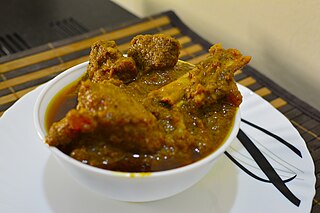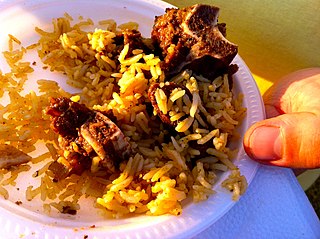Gravy is a sauce made from the juices of meats and vegetables that run naturally during cooking and often thickened with thickeners for added texture. The gravy may be further coloured and flavoured with gravy salt or gravy browning or bouillon cubes. Powders can be used as a substitute for natural meat or vegetable extracts. Canned and instant gravies are also available. Gravy is commonly served with roasts, meatloaf, rice, noodles, fries (chips), mashed potatoes, or biscuits.

Shepherd's pie, cottage pie, or in French cuisine hachis Parmentier, is a savoury dish of cooked minced meat topped with mashed potato and baked, formerly also called Sanders or Saunders. The meat used may be either previously cooked or freshly minced. The usual meats are beef or lamb. The terms shepherd's pie and cottage pie have been used interchangeably since they came into use in the late 18th and early 19th centuries, although some writers insist that a shepherd's pie should contain lamb or mutton, and a cottage pie, beef.

Lancashire hotpot is a stew originating in Lancashire in the North West of England. It consists of lamb or mutton and onion, topped with sliced potatoes and slowly baked in a pot at a low heat.

Lamb and mutton, collectively sheep meat is one of the most common meats around the world, taken from the domestic sheep, Ovis aries, and generally divided into lamb, from sheep in their first year, hogget, from sheep in their second, and mutton, from older sheep. Generally, "hogget" and "sheep meat" are not used by consumers outside Norway, New Zealand, South Africa, Scotland, and Australia. Hogget has become more common in England, particularly in the North often in association with rare breed and organic farming.

Meatloaf is a dish of ground meat that has been combined with other ingredients and formed into the shape of a loaf, then baked or smoked. The final shape is either hand-formed on a baking tray, or pan-formed by cooking it in a loaf pan. It is usually made with ground beef, although ground lamb, pork, veal, venison, poultry, and seafood are also used, sometimes in combination. Vegetarian adaptations of meatloaf may use imitation meat or pulses.
Colonial goose is a preparation of roast leg of lamb or mutton popular as a dish in New Zealand until the last quarter of the 20th century.

Kebab, kebap, kabob, kebob, or (Kashmiri) kabab, is a variety of roasted meat dishes that originated in the Middle East.

Beef bourguignon or bœuf bourguignon, also called beef Burgundy, and bœuf à la Bourguignonne, is a French beef stew braised in red wine, often red Burgundy, and beef stock, typically flavored with carrots, onions, garlic, and a bouquet garni, and garnished with pearl onions, mushrooms. A similar dish using a piece of braised beef with the same garnish is pièce de bœuf à la bourguignonne.

Pasanda, also called Parche, is a popular dish from the Indian subcontinent, notably North India, Rampur, Hyderabadi and Pakistani, derived from a meal served in the court of the Mughal emperors. The word is a variation on the Hindi-Urdu word "pasande" meaning "favourite", which refers to the prime cuts of meat traditionally used in the dish. The word "Pasande" is borrowed from the Persian verb پسندیدن (Pasandidan). The dish may also be prepared with Paneer cheese.

Kerala cuisine is a culinary style originated in the Kerala, a state on the southwestern Malabar Coast of India. Kerala cuisine offers a multitude of both vegetarian and non-vegetarian dishes prepared using fish, poultry and red meat with rice as a typical accompaniment. Chillies, curry leaves, coconut, mustard seeds, turmeric, tamarind, asafoetida and other spices are also used in the preparation.

Quzi, also spelled as qoozi or ghoozi, is a popular rice-based dish and is considered one of Iraq's national dishes. It is served with very slowly cooked lamb, roasted nuts, and raisins served over rice. The dish was introduced into Turkey by Syrian immigrants. The dish can also be found in some Arab states of the Persian Gulf.

The cuisine of Bahrain consists of dishes such as biryani, harees, khabeesa, machboos, mahyawa, quzi and zalabia. Arabic coffee (qahwah) is the national beverage.

Freekeh or farik is a cereal food made from green durum wheat that is roasted and rubbed to create its flavour. It is an ancient dish derived from Levantine and North African cuisines, remaining popular in many countries of the eastern Mediterranean Basin, where durum wheat originated.

Tharid is a bread soup that originates from Mecca, Saudi Arabia, an Arab cuisine also found in many other Arab countries. Like other bread soups, it is a simple meal of broth and bread, in this instance crumbled flatbread moistened with broth or stew. Historically, the flatbread used was probably stale and unleavened. As an Arab national dish it is considered strongly evocative of Arab identity during the lifetime of the Islamic prophet Muhammad. According to a widespread legend, this unremarkable and humble dish was the prophet's favorite food.

Omani cuisine is part of the Khaleeji cuisine and is influenced by Arab, Pakistani cuisine, Iranian, Indian, Asian, Eastern Mediterranean, and African cuisine, reflecting Oman's position as a vast trading empire at the intersection of traditional spice trade routes. Dishes are often based on chicken, fish, and lamb, as well as the staple of rice. Most Omani dishes tend to contain a rich mixture of spices, herbs, and marinades. Omani cuisine differs from other cuisines in the Arabian peninsula, as it is less spicy and seldom served warm.

The cuisine of Mauritania includes the culinary practices of Mauritania. Historically, what is now Mauritania has been influenced by Arab, Berbers and African peoples who have lived in and traversed the "stark" landscape marked with Sahara desert dunes in caravans. There is an overlap with Moroccan cuisine in the north and Senegalese cuisine in the south.

Mutton curry is a dish that is prepared from goat meat and vegetables. The dish is found in different variations across all states, countries and regions of the Indian subcontinent and the Caribbean.

Bariis Iskukaris, also called Isku-dheh karis, or simply referred to as Bariis is a traditional rice dish from Somali cuisine. The name Isku-dheh karis literally means "cooked mixed together", therefore it is sometimes used to more broadly refer to other grain-derived crops that require similar cooking. Hence the more specific term for this dish is bariis isku-dheh karis which means "rice (bariis) cooked mixed together".















